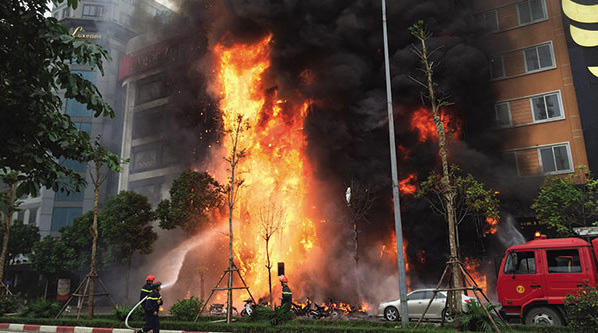Technical classification of fire safety for construction works in Vietnam
What are the regulations on technical classification of fire safety for construction works in Vietnam? – Thuy Trang (HCMC)
Technical classification of fire safety for construction works in Vietnam
This content is guided by Circular 05/2022/TT-BXD on QCVN 03:2022/BXD, the national technical regulation on decentralization of works for construction design promulgated by the Minister of Construction.
Technical classification of fire safety for construction works in Vietnam is prescribed as follows:
1. Technical classification of fire safety for construction works in Vietnam is to establish fire safety requirements when designing and building fire prevention and fighting systems for the building, depending on the function and fire danger of the building.
NOTE: The concepts of fire safety are defined in QCVN 06:2022/BXD.
2. Technical classification of fire safety for construction works in Vietnam is made according to the following criteria:
- Fire resistance grade;
- Structural fire hazard class;
- Fire hazard group according to function.
3. The fire resistance level of the work is classified into 5 levels: I, II, III, IV, and V; depends on the number of floors (or the height of fire protection of the building), the fire hazard group according to the function, the area of the fire compartment, and the fire danger of the technological processes taking place in the building.
NOTE: For apartment buildings with a height of over 75 m and public buildings with a height of over 50 m, QCVN 06:2022/BXD stipulates specific requirements on fire resistance limits of structures and components of works.
4. The structural fire hazard class of the work is classified into 4 levels: S0, S1, S2, and S3; according to the fire hazard of the structure.
5. Works are classified into 5 groups of fire danger according to their function, from F1, F2, F3, F4, and F5; depending on the characteristics of their use and on the degree of threat to the safety of persons in the event of a fire, taking into account: age, physical state, the possibility of someone sleeping, the group of users according to the main function, and the number of people in that group.
6. Fire resistance level, structural fire hazard class, and fire hazard group according to the function of the work are determined according to QCVN 06:2022/BXD.

Technical classification of fire safety for construction works in Vietnam (Internet image)
QCVN 03:2022/BXD National Technical Regulation on Classification of Works for Construction Design in Vietnam
This regulation stipulates the classification of works according to the following criteria:
- Consequences caused by damage or destruction of the work structure (hereinafter referred to as the consequence class);
- The term of use according to the design of the work;
- Technical classification of fire for works (or parts of works, hereinafter referred to as works), including: fire resistance level, structural fire hazard class, and functional fire hazard group.
In this standard, the following terms and definitions are construed as follows:
Fire-resistance grade: The hierarchical characteristic of a building, determined by the fire-resistance limit of the structures and components used to build that work.
Consequence Level: the hierarchical characteristics of the building, depending on the use of the building, as well as the human damage and social, environmental, and economic consequences when the structure is damaged or destroyed.
Structure fire hazard class: The hierarchical characteristic of the building, determined by the degree of participation of the building structure in the development of fire and the formation of fire hazard factors.
Long durability: The ability of a building to preserve its durability, physical properties, and other properties specified in the design and to ensure the building's normal use throughout its design life.
Building structure: A combination of parts and components of a building that bears all loads and impacts on the building, and ensures the strength, rigidity, and stability of the building.
Group of fire danger according to the function of the works: Grouping characteristics of a building, determined by its function and specific use characteristics, including the characteristics of the technological processes of production in that building.
Major repair (for building structures): The operation of replacing, reinforcing, or restoring structural components and components or reinforcing the foundation to bring them back to normal working condition.
NOTE: Repair or replacement of covering, decoration, finishing, or structural protection layers during maintenance is not considered a major repair.
Duong Chau Thanh
- Key word:
- fire safety
- in Vietnam
- construction works
- Guidelines for registering changes of the legal representative of limited liability companies and joint stock companies in Vietnam
- Guidelines on updating and supplementing information in the enterprise registration dossier in Vietnam
- Is forcing a partner to have an abortion a criminal offense according to the law in Vietnam?
- Guidelines for training A1 class motorcycle drivers for ethnic minorities who cannot read or write Vietnamese
- Guidelines on verifying the completion of the driver training courses for categories B, C1 in Vietnam
- Types of specialized motor vehicles according to new regulations in Vietnam
-

- Strengthening the management of building order ...
- 10:25, 24/12/2024
-

- Emergency response and search and rescue organizations ...
- 10:29, 11/09/2024
-

- Handling of the acceptance results of ministerial ...
- 09:30, 11/09/2024
-

- Regulations on the database of investment and ...
- 10:30, 10/09/2024
-

- Guidance on unexploded ordnance investigation ...
- 18:30, 09/09/2024
-

- Guidelines for the maintenance of hydraulic infrastructure ...
- 08:44, 22/01/2025
-

- Supplementing regulations on alcohol concentration ...
- 16:21, 21/01/2025
-

- Action program on power control, anti-corruption ...
- 15:52, 21/01/2025
-

- Principles of merger and consolidation of credit ...
- 15:45, 21/01/2025
-

- Conditions for establishment of public service ...
- 15:41, 21/01/2025
 Article table of contents
Article table of contents
